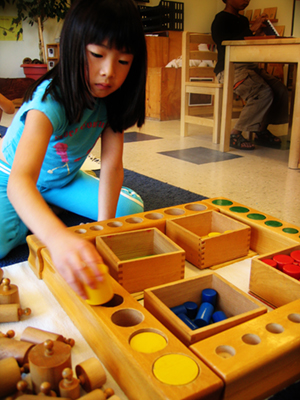Those of us in Montessori education see the positive effects of Montessori on a daily basis. We watch as children’s fine motor skills are strengthened, their reasoning skills sharpened, and their independence encouraged through daily interaction with the prepared Montessori environment.
But we can watch all of that and not actually know how the Montessori method achieves the results that it does. Is it just a happy stroke of luck that Montessori materials seem to promote brain development?
It’s more than just a coincidence. Pediatric neuropsychologist and Montessori parent Steve Hughes believes that Montessori curriculum triggers specific brain functions that greatly aid cognitive development. In fact, he refers to Montessori as “the original brain-based method of learning.”
Dr. Hughes completed his Ph.D in clinical psychology at the University of Minnesota and his post-doctoral fellowship in pediatric neuropsychology at the University of Minnesota Medical School, where he joined the faculty of the Division of Pediatric Clinical Neurosciences in 2001.
In his clinical work, he has studied the neurodevelopmental benefits of classical Montessori education. He gives presentations at Montessori and educational conferences on the connection between Montessori and brain development. He has a lot to say about Montessori and the brain.
The Hand-to-Brain Connection
In an article from Public School Montessorian, Hughes gives an example the task of learning to read, a basic building block of education for all children regardless of schooling method. Reading requires three separate brain functions: capturing visual symbols, decoding each symbol’s sound, and assigning each symbol meaning. While each of these brain functions can be taught separately, Montessori materials such as the Sandpaper Letters and Moveable Alphabet encourage simultaneous use of each function, resulting in neurological networks that coordinate reading.
Hughes also focuses on the tactile methods of Montessori as they relate to brain development, asserting that the hands are a child’s strongest link to the brain. When motor movements are repeated they become templates in the brain that serve as a starting point for new experiences.
Because Montessori emphasizes hands-on learning, children are able to master information more quickly and easily than when conventional educational methods are used. The repetition of activities, multisensory materials, and self-guided learning common to the Montessori classroom create the perfect “recipe” for human brain development.
It is interesting to note that much of Maria Montessori’s early work in education lay in the treatment of special needs children. Today, intervention methods for special needs students closely resemble Montessori methods, suggesting perhaps that what Montessori has been doing for over 100 years is extremely effective in creating and strengthening neural pathways.
Mirror Neurons
Physical movements are not the only method of brain development supported by Montessori education. Maria Montessori spoke of the “absorbent mind” of a child being like a sponge literally soaking up what they see and do. Although at the time she had little actual neurological research to back up her claim, a new discovery in the area of neurology, called mirror neurons, goes hand in hand with her hypotheses.
Mirror neurons are found in the frontal lobe of humans and other species, including primates and birds, and fire when an animal or human performs an action or when that animal or human observes another animal of the same species performing the same action.
While research in the area of mirror neurons is ongoing, scientists believe that they show the importance of learning by example or imitation. The Montessori classroom, with its presentations, its multi-age groupings, and repetition of work is the perfect place for children to observe as well as act.
A child who watches another child move the Pink Tower blocks is having neural pathways strengthened even though they are not moving the blocks themselves. There is also evidence that mirror neurons come into play in a social context, teaching response to emotions and appropriate ways to solve social problems.
Where does that leave us?
I’m extremely excited about Dr. Hughes’ work. In my conversations with people who are skeptical of the Montessori method, one of the first things they mention is a desire to see scientific proof that Montessori is beneficial. I am now going to point them towards Dr. Hughes’ research. According to his website, he is in the process of authoring a book on Montessori and the brain and I am eager to read it.
 It is amazing to me that Dr. Montessori was able to develop her materials without the benefits of today’s technology. She could not view a child’s brain to see which areas lit up when they were using the Cylinder Blocks, and yet through observation she knew that a child’s fine motor skills, shape and size discrimination, and hand/eye coordination were being strengthened through this work.
It is amazing to me that Dr. Montessori was able to develop her materials without the benefits of today’s technology. She could not view a child’s brain to see which areas lit up when they were using the Cylinder Blocks, and yet through observation she knew that a child’s fine motor skills, shape and size discrimination, and hand/eye coordination were being strengthened through this work.
Dr. Hughes’ work is a reminder that Maria Montessori was herself a scientist before she was an educator. She didn’t guess at the materials she created; she observed, made changes based on her observations, and observed some more. She let the children teach her rather than pushing her own ideas on them.
The fundamental touchstones of educating through Montessori – preparing a natural and supporting environment, and adapting that environment for a child to fulfill his or her greatest potential – have proven to be more than helpful educational theory. The Montessori method holds a proven place in creating neural pathways that facilitate cognitive development.
Picture courtesy of Montessori Greeting Cards.

